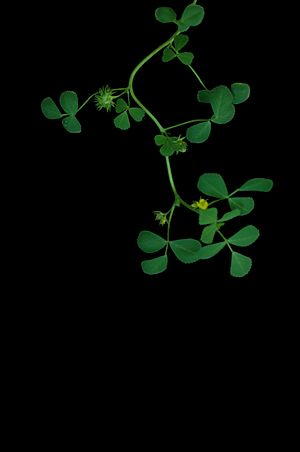Barrelclover facts for kids
Quick facts for kids Barrelclover |
|
|---|---|
 |
|
| Conservation status | |
| Scientific classification | |
| Synonyms | |
|
Medicago tribuloides Desr. |
Medicago truncatula, also known as barrelclover or barrel medic, is a small plant that grows every year. It belongs to the legume family, like peas and beans. This plant originally comes from the Mediterranean area.
Scientists use Medicago truncatula a lot in their research. It helps them understand how plants grow and interact with other living things. It's a bit like a "lab rat" for plant studies.
This plant is small, usually growing about 10 to 60 centimeters (4 to 24 inches) tall. Its leaves look like clover leaves, with three small leaflets. Each leaflet is round and about 1 to 2 centimeters long, often with a dark spot in the middle. Its yellow flowers are small and grow either alone or in small groups. The fruit is a tiny, spiny pod.
Medicago truncatula is a great plant for research because it has a small genome (all its genetic information). It can also fertilize itself, grows quickly, and produces many seeds. Scientists can easily change its genes, and its entire genome has been mapped out.
Contents
Why Medicago truncatula is a Model Plant
Scientists call Medicago truncatula a "model organism" because it's easy to study in the lab. It helps them learn about important plant processes.
Understanding Plant Partnerships
One key reason it's studied is its ability to form special partnerships, called symbioses, with tiny living things in the soil.
- Rhizobia Bacteria: It works with nitrogen-fixing bacteria called Sinorhizobium meliloti and Sinorhizobium medicae. These bacteria live in the plant's roots and help turn nitrogen from the air into a form the plant can use to grow. This process is called nitrogen fixation.
- Mycorrhizal Fungi: It also partners with arbuscular mycorrhizal fungi, like Rhizophagus irregularis. These fungi help the plant get nutrients, especially phosphorus, from the soil.
Another famous model plant, Arabidopsis thaliana, doesn't form these partnerships. This makes Medicago truncatula very important for scientists who want to understand how these helpful relationships work.
A Useful Crop
Besides being a research tool, Medicago truncatula is also an important plant for feeding animals in places like Australia. It's grown as a "forage" crop, meaning animals like cattle eat it.
Mapping the Medicago Genome
In 2011, scientists published the first draft of the complete genetic map, or sequence, of Medicago truncatula. This was a big step forward!
Who Mapped the Genome?
Many research groups from different countries worked together on this huge project. Some of the main groups were from the University of Oklahoma (US), J. Craig Venter Institute (US), Genoscope (France), and the Sanger Centre (UK).
The project started in 2001 with some early funding. By 2003, major organizations like the National Science Foundation and the European Union began providing most of the money. By 2009, most of the genome was mapped.
How the Genome Was Mapped
Scientists used a method called bacterial artificial chromosomes (BACs) to map the genome. This is the same method used to map the human genome and other important model organisms. In 2013, an improved version of the genome map was released. This new version combined different mapping techniques to fill in any missing parts.
Another group, called the International Medicago Gene Annotation Group (IMGAG), works on finding and describing the different genes within the mapped genome.
Plant-Fungi Partnerships: A Fair Trade?
Scientists have used Medicago truncatula to study how plants and fungi interact. They wanted to see if plants could tell the difference between helpful and less helpful fungi.
Researchers found that plants gave more of their carbon (a type of food) to the fungi that were more generous in sharing phosphorus (a nutrient). They also showed that fungi gave more phosphorus to plants that were more generous with their carbon. This suggests that these partnerships are like a "fair trade" system!
See also
 In Spanish: Medicago truncatula para niños
In Spanish: Medicago truncatula para niños


